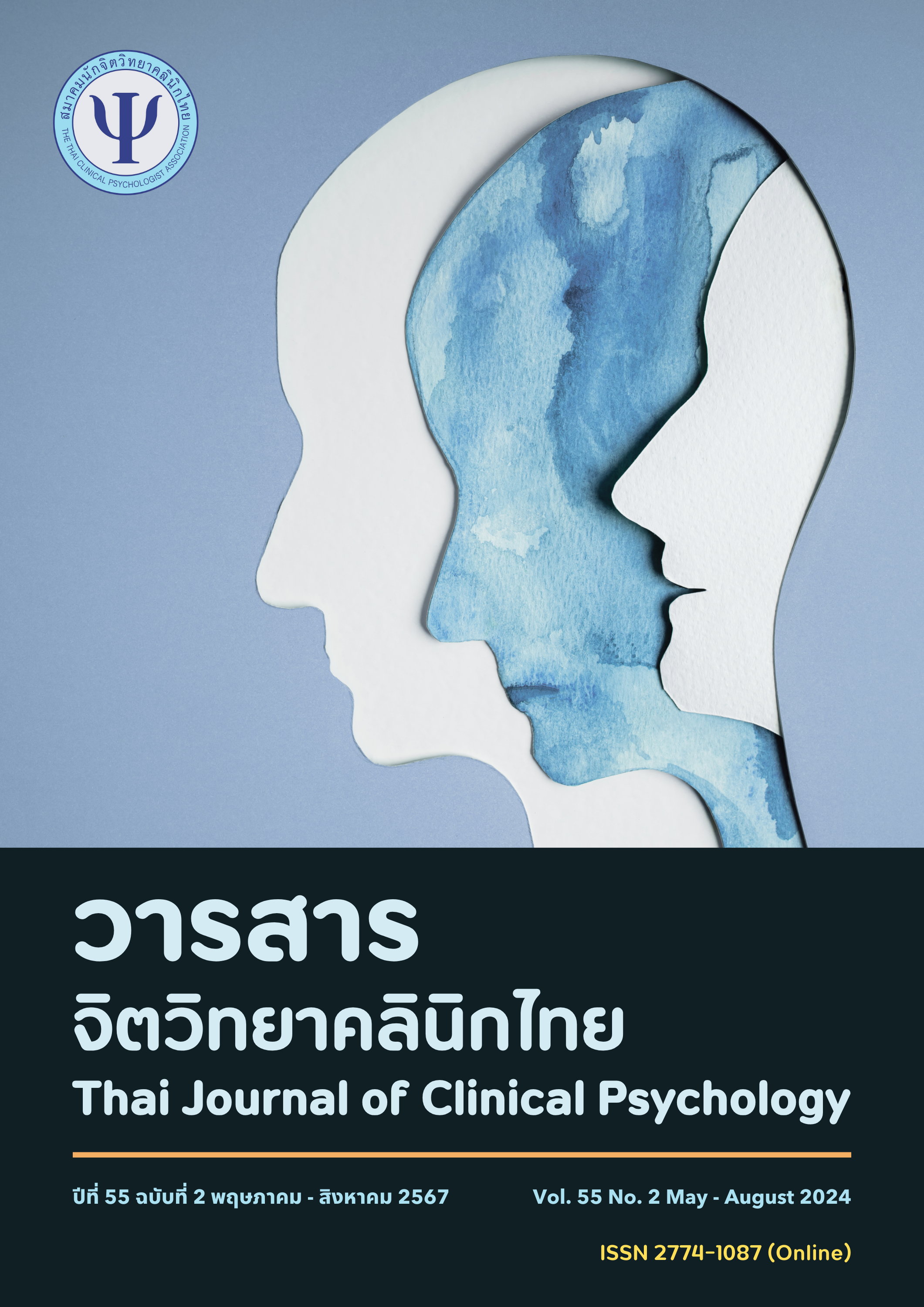การพัฒนาแบบประเมินการรู้คิดทางสังคมเพื่อการฟื้นฟูสมรรถภาพผู้ป่วยจิตเภทเรื้อรัง
Main Article Content
บทคัดย่อ
วัตถุประสงค์ 1) พัฒนาแบบประเมินการรู้คิดทางสังคมสำหรับผู้ป่วยจิตเภท 2) ศึกษาคุณสมบัติทางการวัดทางจิตวิทยา (psychometric properties) ของแบบประเมินที่พัฒนาขึ้น วัสดุและวิธีการ การวิจัยครั้งนี้เป็นการวิจัยและพัฒนา (research and development) แบ่งเป็น 2 ระยะคือ 1) พัฒนาแบบประเมินการรู้คิดทางสังคมสำหรับผู้ป่วยจิตเภทและศึกษาความเที่ยงตรงเชิงเนื้อหา 2) ศึกษาความเที่ยงตรงเชิงโครงสร้างและความเที่ยงตรงตามสภาพ กลุ่มตัวอย่าง คือ ผู้ป่วยจิตเภทอายุ18-59 ปีที่มารับบริการที่โรงพยาบาลศรีธัญญา ในเดือนกุมภาพันธ์ 2567 มีคุณสมบัติตามเกณฑ์คัดเข้าจำนวน 140 คน วิเคราะห์ความเที่ยงตรงเชิงโครงสร้างด้วย factor analysis วิเคราะห์ค่าสัมประสิทธิ์อัลฟาของครอนบาค (Cronbach’ s alpha coefficients ) เพื่อทดสอบความเชื่อมั่นและความสอดคล้องภายใน และศึกษาความเที่ยงตรงตามสภาพร่วมกับแบบทดสอบ WAIS-III ด้วย Pearson’s correlation ผลการศึกษา แบบประเมินฉบับร่างประกอบด้วย 4 ด้าน จำนวน 31 ข้อ คือ 1) ด้านการรับรู้อารมณ์ 2) ด้านทฤษฎีของจิต 3) ด้านการรับรู้ทางสังคม และ 4) ด้านอคติในการระบุเหตุผ่านเกณฑ์ความตรงเชิงเนื้อหา 22 ข้อวิเคราะห์ข้อคำถามผ่านเกณฑ์จำนวน 20 ข้อและมีค่าความเชื่อมั่นรายด้านเท่ากับ 0.86, 0.74, 0.80 และ 0.72 ตามลำดับ วิเคราะห์ความเที่ยงตรงเชิงโครงสร้างด้วยการวิเคราะห์องค์ประกอบเชิงยืนยันพบว่า โมเดลมีความสอดคล้องกลมกลืนกับข้อมูลเชิงประจักษ์ส่วนความเที่ยงตรงตามสภาพพบว่า ทุกองค์ประกอบมีความสัมพันธ์กับแบบทดสอบย่อย Picture Arrangement, Picture Completion และ Object Assembly อย่างมีนัยสำคัญทางสถิติ สรุป แบบประเมินที่ได้ประกอบด้วย 4 ด้าน จำนวน 20 ข้อ มีคุณสมบัติด้านความเที่ยงตรงและความเชื่อมั่นสามารถใช้ในการประเมินการรู้คิดทางสังคมของผู้ป่วยจิตเภทได้และควรศึกษาเพื่อหาจุดตัดที่เหมาะสมต่อไป
Article Details

อนุญาตภายใต้เงื่อนไข Creative Commons Attribution-NonCommercial-NoDerivatives 4.0 International License.
เรื่องที่ลงตีพิมพ์ในวารสารจิตวิทยาคลินิกแล้วถือเป็นลิขสิทธิ์การเผยแพร่โดยวารสารจิตวิทยาคลินิกแต่เพียงผู้เดียว การตีพิมพ์หรือเผยแพร่ซ้ำในที่อื่นต้องได้รับอนุญาตจากกองบรรณาธิการวารสารฯ
เอกสารอ้างอิง
Allen, D. N., & Barchard, K. A. (2009). Identification of a social cognition construct for the WAIS-III. Applied Neuropsychology, 16(4), 262-74. https://doi.org/0.1080/09084280903297727.
Baron-Cohen, S., Jolliffe, T., Mortimore, C., & Robertson, M. (1997). Another advanced test of theory of mind: Evidence from very high
functioning adults with autism or Asperger syndrome. J Child Psychol Psychiatry, 38, 813-822.
Baron-Cohen, S., Wheelwright, S., Hill, J., Raste, Y, & Plumb, I. (2001). The “reading the mind in the eyes” test revised version: A study with normal adults, and adults with Asperger syndrome or high-functioning autism. J Child Psychol Psychiatry, 42(2), 241-51. https://pubmed.ncbi.nlm.nih.gov/11280420/
Charernboon, T., & Patumanond, J. (2017). Social cognition in schizophrenia. Ment Illn, 9(1), 7054. https://doi.org/10.4081/mi.2017.7054.
Corrigan, P. W., Silverman, R., Stephenson, J., Nugent-Hirschbeck, J., & Buican, B. J. (1996). Situational familiarity and feature recognition
in schizophrenia. Schizophr Bull, 22(1), 153-61. https://doi.org/10.1093/schbul/22.1.153
Corrigan, P. W., & Penn, D. L. (Eds.). (2001). Social cognition and schizophrenia. American Psychological Association. https://doi.org/
1037/10407-000
Division of Psychology. (2020). Handbook of group cognitive remediation for chronic schizophrenia [Unpublished manuscript]. Srithanya Hospital, Nonthaburi. (in Thai).
Fett, A. K. J., Viechtbauer, W., Dominguez, M.-deG., Penn, D. L., Os, J. V., & Krabbendam, L. (2011). The relationship between neurocognition and social cognition with functional outcomes in schizophrenia: A meta-analysis. Neurosci
Biobehav Rev, 35(3), 573-88. https://doi.org/0.1016/j.neubiorev.2010.07.001.
Green, M. F., Kern, R. S., Braff, D. L., & Mintz, J. (2000). Neurocognitive deficits and functional outcome in schizophrenia: Are we measuring the “right stuff”? Schizophrenia Bulletin, 26, 119-136. https://doi.org/10.1093/oxfordjournals. schbul.a033430.
Green, M. F., Penn, D. L., Bentall, R., Carpenter, W. T., Gaebel, W., Gur, R. C., Kring, A. M., Park, S., Silverstein, S.M., & Heinssen, R. (2008). Social Cognition in schizophrenia: An NIMH workshop on definitions, assessment, and research opportunities. Schizophrenia Bulletin, 34(6), 1211-1220. https://doi.org/10.1093/schbul/sbm145
Harvey, P. D., & Penn, D. (2010). Social cognition: The key factor predicting social outcome in people with schizophrenia? Psychiatry, 7, 41-44.
Horan, W. P., Kern, R. S., Shokat-Fadai, K., Sergi, M. J., Wynn, J. K., & Green, M. F. (2009). Social cognitive skills training in schizophrenia: An initial efficacy study of stabilized outpatients. Schizophrenia Research, 107(1), 4754. https://doi.org/10.1016/j.schres.2008.09.006
Horan, W. P., Green, M. F., DeGroot, M., Fiske, A., Hellemann, G., Kee, K. Kern, R.S., Lee, J., Sergi, M. J., Subotnik, K. L., Sugar, C. A., Ventura, J., & Nuechterlein, K. H. (2012). Social cognition in schizophrenia, Part 2: 12-month stability and prediction of functional outcome in firstepisode patients. Schizophr Bull, 38, 865-72. https://doi.org/10.1093/schbul/sbr001
Lotrakul, M., & Sukanit, P. (Eds). (2015). Ramathibodi’s essential of psychiatry (4th ed). Faculty of Medicine Ramathibodi Hospital. (in
Thai).
Pinkham, A. E., Penn, D. L., Green, M. F., Buck, B., Healey, K. & Harvey, P. D. (2014). The social cognition psychometric evaluation study:
Results of the expert survey and RAND panel. Schizophr Bull,40, 813-23. https://doi.org/10.1093/schbul/sbt081.
Pinkham, A. E., Penn, D. L., Green, M. F., & Harvey, P. D. ( 2016) . Social cognition psychometric evaluation: Results of the initial psychometric study. Schizophrenia Bulletin, 42(2), 494-504.https://doi.org/10.1093/schbul/sbv056
Polit, D. F., & Beck, C. T. (2006). The content validity index: Are you sure you know what’s being reported? Critique and recommendations. Research in Nursing & Health, 29(1), 489-497. https://doi.org/10.1002/nur.20147
Suksai, P., Sakulsriprasert, C., Supreeyaporn, N., & Potikul, S. (2023). Difficulties in emotion regulation and alcohol-related problems amongundergraduate students: The mediating role of drinking motives. Thai Journal of Clinical Psychology, 54(1), 1-11. https://so03.tcithaijo.org/index.php/tci-thaijclinicpsy/article/view/263565/177201
Swartz, M. S., Perkins, D. O., Stroup, S. T., Davis, S. M., Capuano, G., Rosenheck, R. A., Reimherr, F., McGee, M. F., Keefe, R. S. E., McEvoy, J. P., Hsiao, J. K., & Lieberman, J. A. (2007). Effects of antipsychotic medications on psychosocial functioning in patients with chronic
schizophrenia: Findings from the NIMH CATIE study. Am. J. Psychiatry, 164, 428-436. https://doi.org/10.1176/ajp.2007.164.3.428
Whiteford, H. A., Degenhardt, L., Rehm, J., Baxter, A. J., Ferrari, A. J., Erskine, H. E., Charlson, F. J., Norman, R. E., Flaxman, A. D., Johns, N.,
Burstein, R., Murray, C. J. L., & Vos, T. (2013). Global burden of disease attributable to mental and substance use disorders: Findings
from the global burden of disease study 2010. The Lancet, 382 (9904), 1575-1586.
WongRattana, C. (1998). Statistics application technique for research. Thepnimit Kan Pim. (in Thai)


